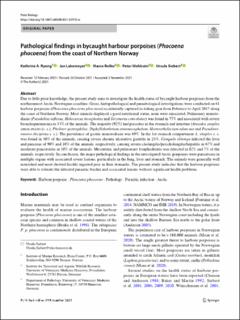| dc.description.abstract | Due to little prior knowledge, the present study aims to investigate the health status of bycaught harbour porpoises from the northernmost Arctic Norwegian coastline. Gross, histopathological and parasitological investigations were conducted on 61 harbour porpoises (Phocoena phocoena phocoena) accidentally captured in fishing gear from February to April 2017 along the coast of Northern Norway. Most animals displayed a good nutritional status, none were emaciated. Pulmonary nematodiasis (Pseudalius inflexus, Halocercus invaginatus and Torynurus convolutus) was found in 77% and associated with severe bronchopneumonia in 33% of the animals. The majority (92%) had parasites in the stomach and intestine (Anisakis simplex sensu stricto (s. s.), Pholeter gastrophilus, Diphyllobothrium stemmacephalum, Hysterothylacium aduncum and Pseudoterranova decipiens s. s.). The prevalence of gastric nematodiasis was 69%. In the 1st stomach compartment A. simplex s. s. was found in 30% of the animals, causing severe chronic ulcerative gastritis in 23%. Campula oblonga infected the liver and pancreas of 90% and 10% of the animals, respectively, causing severe cholangitis/pericholangitis/hepatitis in 67% and moderate pancreatitis in 10% of the animals. Mesenteric and pulmonary lymphadenitis was detected in 82% and 7% of the animals, respectively. In conclusion, the major pathological findings in the investigated Arctic porpoises were parasitoses in multiple organs with associated severe lesions, particularly in the lung, liver and stomach. The animals were generally well nourished and most showed freshly ingested prey in their stomachs. The present study indicates that the harbour porpoises were able to tolerate the detected parasitic burden and associated lesions without significant health problems. | en_US |
